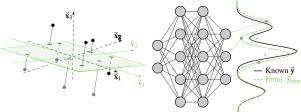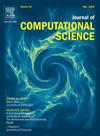Implementation of the emulator-based component analysis
IF 3.1
3区 计算机科学
Q2 COMPUTER SCIENCE, INTERDISCIPLINARY APPLICATIONS
引用次数: 0
Abstract
We present a PyTorch-powered implementation of the emulator-based component analysis used for ill-posed numerical non-linear inverse problems, where an approximate emulator for the forward problem is known. This emulator may be a numerical model, an interpolating function, or a fitting function such as a neural network. With the help of the emulator and a data set, the method seeks dimensionality reduction by projection in the variable space so that maximal variance of the target (response) values of the data is covered. The obtained basis set for projection in the variable space defines a subspace of the greatest response for the outcome of the forward problem. The method allows for the reconstruction of the coordinates in this subspace for an approximate solution to the inverse problem. We present an example of using the code provided as a Python class.

实施基于仿真器的组件分析
我们介绍了一种 PyTorch 驱动的基于仿真器的分量分析实现,该实现用于已知前向问题近似仿真器的问题。该仿真器可以是一个数值模型、一个插值函数或一个拟合函数(如神经网络)。在仿真器和数据集的帮助下,该方法通过在变量空间中进行投影来降低维度,从而覆盖数据目标(响应)值的最大方差。获得的变量空间投影基集定义了前向问题结果的最大响应子空间。该方法允许在该子空间中重建坐标,以获得逆问题的近似解。我们将举例说明如何使用 Python 类提供的代码。
本文章由计算机程序翻译,如有差异,请以英文原文为准。
求助全文
约1分钟内获得全文
求助全文
来源期刊

Journal of Computational Science
COMPUTER SCIENCE, INTERDISCIPLINARY APPLICATIONS-COMPUTER SCIENCE, THEORY & METHODS
CiteScore
5.50
自引率
3.00%
发文量
227
审稿时长
41 days
期刊介绍:
Computational Science is a rapidly growing multi- and interdisciplinary field that uses advanced computing and data analysis to understand and solve complex problems. It has reached a level of predictive capability that now firmly complements the traditional pillars of experimentation and theory.
The recent advances in experimental techniques such as detectors, on-line sensor networks and high-resolution imaging techniques, have opened up new windows into physical and biological processes at many levels of detail. The resulting data explosion allows for detailed data driven modeling and simulation.
This new discipline in science combines computational thinking, modern computational methods, devices and collateral technologies to address problems far beyond the scope of traditional numerical methods.
Computational science typically unifies three distinct elements:
• Modeling, Algorithms and Simulations (e.g. numerical and non-numerical, discrete and continuous);
• Software developed to solve science (e.g., biological, physical, and social), engineering, medicine, and humanities problems;
• Computer and information science that develops and optimizes the advanced system hardware, software, networking, and data management components (e.g. problem solving environments).
 求助内容:
求助内容: 应助结果提醒方式:
应助结果提醒方式:


